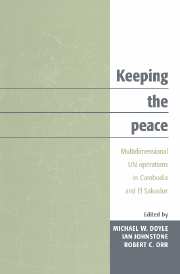Book contents
- Frontmatter
- Contents
- Preface
- Notes on the contributors
- List of abbreviations
- 1 Introduction
- Cambodia
- El Salvador
- Map
- 9 Insurrection and civil war in El Salvador
- 10 Peacemaking in El Salvador
- 11 The El Salvador Peace Accords: using international and domestic law norms to build peace
- 12 From peacekeeping to peacebuilding: restructuring military and police institutions in El Salvador
- 13 Rights and reconciliation in El Salvador
- 14 The arms-for-land deal in El Salvador
- Conclusion and chronologies
- Select bibliography
- Index
13 - Rights and reconciliation in El Salvador
Published online by Cambridge University Press: 22 October 2009
- Frontmatter
- Contents
- Preface
- Notes on the contributors
- List of abbreviations
- 1 Introduction
- Cambodia
- El Salvador
- Map
- 9 Insurrection and civil war in El Salvador
- 10 Peacemaking in El Salvador
- 11 The El Salvador Peace Accords: using international and domestic law norms to build peace
- 12 From peacekeeping to peacebuilding: restructuring military and police institutions in El Salvador
- 13 Rights and reconciliation in El Salvador
- 14 The arms-for-land deal in El Salvador
- Conclusion and chronologies
- Select bibliography
- Index
Summary
Introduction
The centrality of human rights to the El Salvador peace process is not surprising given the history of that country's conflict. The San José Agreement on Human Rights was the first substantive agreement reached by the parties. ONUSAL was initially deployed as a human rights verification mission, and three commissions were established to investigate past abuses and make recommendations on how to overcome the culture of impunity that plagued the country. Participatory opportunities were expanded, first and foremost by legitimizing the FMLN as a political party, but also through electoral reforms and the establishment of the National Commission for the Consolidation of Peace (COPAZ) so “civilian society” could participate “in the process of the changes resulting from the negotiations.” Perhaps most importantly, a serious attempt was made to overhaul the justice system by renovating and reforming historically corrupt institutions.
Neither of the parties nor the UN expected to deal with human rights monitoring first in the negotiations; the armed forces headed the list of items set out in the Caracas Agenda. However, when early agreement on the armed forces (and most other items on the agenda) proved to be impossible, in July 1990, the UN intermediary Alvaro de Soto put the issue of human rights on the table and, after a day of intense negotiations, the San José Agreement was signed.
- Type
- Chapter
- Information
- Keeping the PeaceMultidimensional UN Operations in Cambodia and El Salvador, pp. 312 - 341Publisher: Cambridge University PressPrint publication year: 1997



